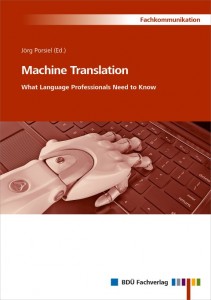Review of  Jörg Porsiel (ed.): Machine Translation. What language Professionals Need to Know. 260 pages. BDÜ Fachverlag 2017. €49. Order here (“Warenkorb” means “Shopping basket”).
Jörg Porsiel (ed.): Machine Translation. What language Professionals Need to Know. 260 pages. BDÜ Fachverlag 2017. €49. Order here (“Warenkorb” means “Shopping basket”).
If you are interested in machine translation (MT) and would like to know more – in fact a lot – about it without having to trawl the internet (and getting a lot of less interesting hits), you can hardly do better than reading this recently published book. It contains 22 contributions on every aspect of MT, from its development and various technical viewpoints (such as the roles of controlled language and of terminology and the integration of MT in CAT environments; also – and very interesting, too – data protection under the GDPR, that is the European Union’s General Data Protection Regulation) to quality management (a very interesting text on the amalgamation of the TAUS Dynamic Quality Framework and the German Multidimensional Quality Metrics into a common error typology) and, lastly, to a number of practical examples (the European Commission, Volkswagen, Microsoft, ZF, and Catalonia).
In addition, a sizeable portion of the book (54 pages) centres on so-called post-editing, that is, the “manual reworking of MT output”, as the book’s glossary phrases it. It covers the new standard on post-editing, ISO 18587; the education of post-editors; “strategies” for post-editing; and a “field report” by a translator who has worked as a post-editor for ten years.
What is particularly interesting here is that there are differing viewpoints on some essential matters. For one thing, both the field report and the text on education makes it quite clear that post-editing means getting a pre-translated (via MT) document for editing and making it ship-shape. This is not at all obvious in the other texts. In fact, some of them clearly includes interactive translation in a CAT tool with the aid of MT – this is the case with the text on the pricing of post-editing services, which is based only on such interactive translation (but it’s still very interesting).
For another, there are obviously differing views on the meaning of “full” post-editing. The ISO standard is quoted as specifying that such editing shall result in a text that “must be indistinguishable from a human translation”. But in other places we learn that “stylistic perfection is also not expected” nor is linguistic perfection, and that “post-editing is not the same as traditional translation, and that customers/clients do not want it to be [italics mine]” – the latter statement by the experienced post-editor, which makes it particularly notable.
The texts are generally easy to read, even if the occasional one can be very technical (the text on terminology is a case in point), and some of the practical examples contain historical material which may be less interesting to the general reader. But in all, this is a gold mine for anyone more than cursorily interested in this exciting field, and you are likely to return to it many times, which makes it worth its price. You will hardly find a more comprehensive – and up-to-date – overview of the MT world anywhere; that it is very much centered on the practical side of things makes it all the more useful. And I would say it is particularly valuable to the freelance translator who wants to know what the future is likely to hold (unless you mainly translate fiction, poetry and drama).
There is a brief presentation by the publisher here. And there are sample pages – 14 of them, including the contents list – in English here.

 Posted in
Posted in